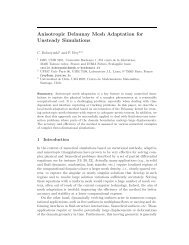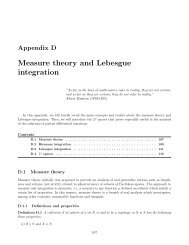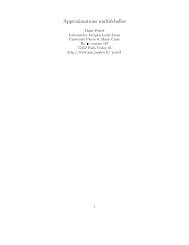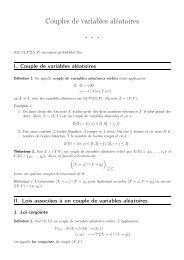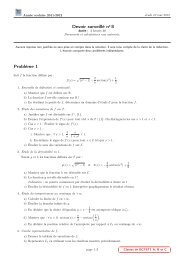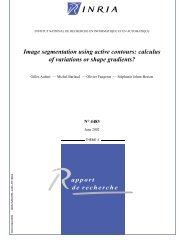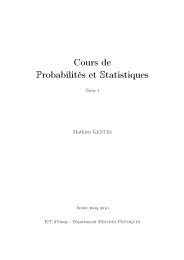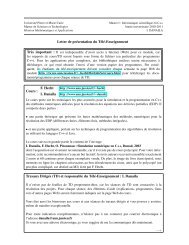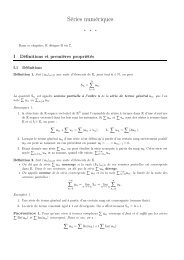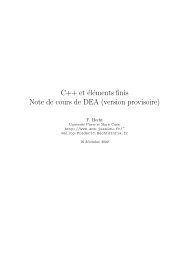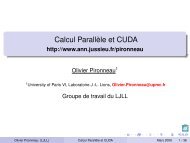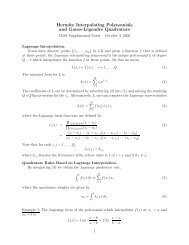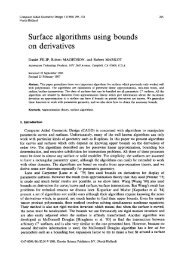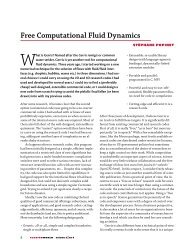pdf file
pdf file
pdf file
Create successful ePaper yourself
Turn your PDF publications into a flip-book with our unique Google optimized e-Paper software.
BOGOLIUBOV SPECTRUM OF INTERACTING BOSE GASES 11<br />
HN to F + . We see that, in the limit N → ∞, the Fock space F+ of excited<br />
particles arises naturally as the limit of the truncated Fock spaces F ≤N<br />
+ .<br />
The operator UN is a mathematical tool which implements what is called<br />
a c-number substitution [40, 39]. In Fock space the usual way to formalize<br />
the c-number substitution is to use the Weyl operator, and here UN plays<br />
the same role. The difference is that the Weyl operator is defined on the<br />
whole Fock space F with values in F, while with the operator UN we go<br />
immediately from the N-body space HN to the excitation Fock space F+,<br />
which is a proper subspace of F. We shall give important properties of the<br />
operator UN in Section 4.<br />
One of our main results will be that<br />
� � ∗<br />
UN HN −N eH UN → H<br />
in an appropriate (weak) sense.<br />
2.4. Convergence of the excitation spectrum. A convenient way to<br />
describe the lower eigenvalues is to use the min-max principle (see [47]). If<br />
A is a self-adjoint operator, which is bounded from below, on a (separable)<br />
Hilbert space, then we may define the min-max values<br />
λL(A) := inf<br />
Y subspace<br />
dimY=L<br />
max 〈Φ,AΦ〉<br />
Φ∈Y<br />
||Φ||=1<br />
for L = 1,2,.... It is known that limL→∞λL(A) = infσess(A), where we use<br />
the convention that infσess(A) = +∞ when the essential spectrum of A is<br />
empty. Moreover, if<br />
λL(A) < infσess(A),<br />
then{λj(A)} L j=1<br />
arethelowest Leigenvalues ofA, countedwithmultiplicity.<br />
Our main result is the following.<br />
Theorem 2 (Convergence of the excitation spectrum). Assume that (A1)-<br />
(A2)-(A3) hold true.<br />
(i) (Weak convergence to H). For every fixed Φ and Φ ′ in the quadratic form<br />
domain of the Bogoliubov Hamiltonian H, we have<br />
� � � ′ ∗<br />
lim Φ ,UN HN −N eH UN Φ<br />
N→∞<br />
�<br />
F+ = � Φ ′ ,HΦ �<br />
(19) F+<br />
where UN is defined in (18) and by convention U∗ N is extended to 0 outside<br />
of F ≤N<br />
+ .<br />
(ii) (Convergence of eigenvalues). Let λ1(HN) ≤ λ2(HN) ≤ ... and λ1(H) ≤<br />
λ2(H) ≤ ... be the min-max values of HN in HN and H in F+, respectively.<br />
We have<br />
� �<br />
lim<br />
N→∞<br />
λL(HN)−NeH = λL(H)<br />
for every L = 1,2,.... Consequently, we have the spectral gap<br />
�<br />
�<br />
liminf infσess(HN)−λ1(HN) ≥ infσess(H)−λ1(H) = infσess(h) > 0.<br />
N→∞<br />
(iii) (Convergence of the ground state). The Hamiltonian H has a unique<br />
ground state Φ (1) in F+ (up to a phase factor) and HN also has a unique



